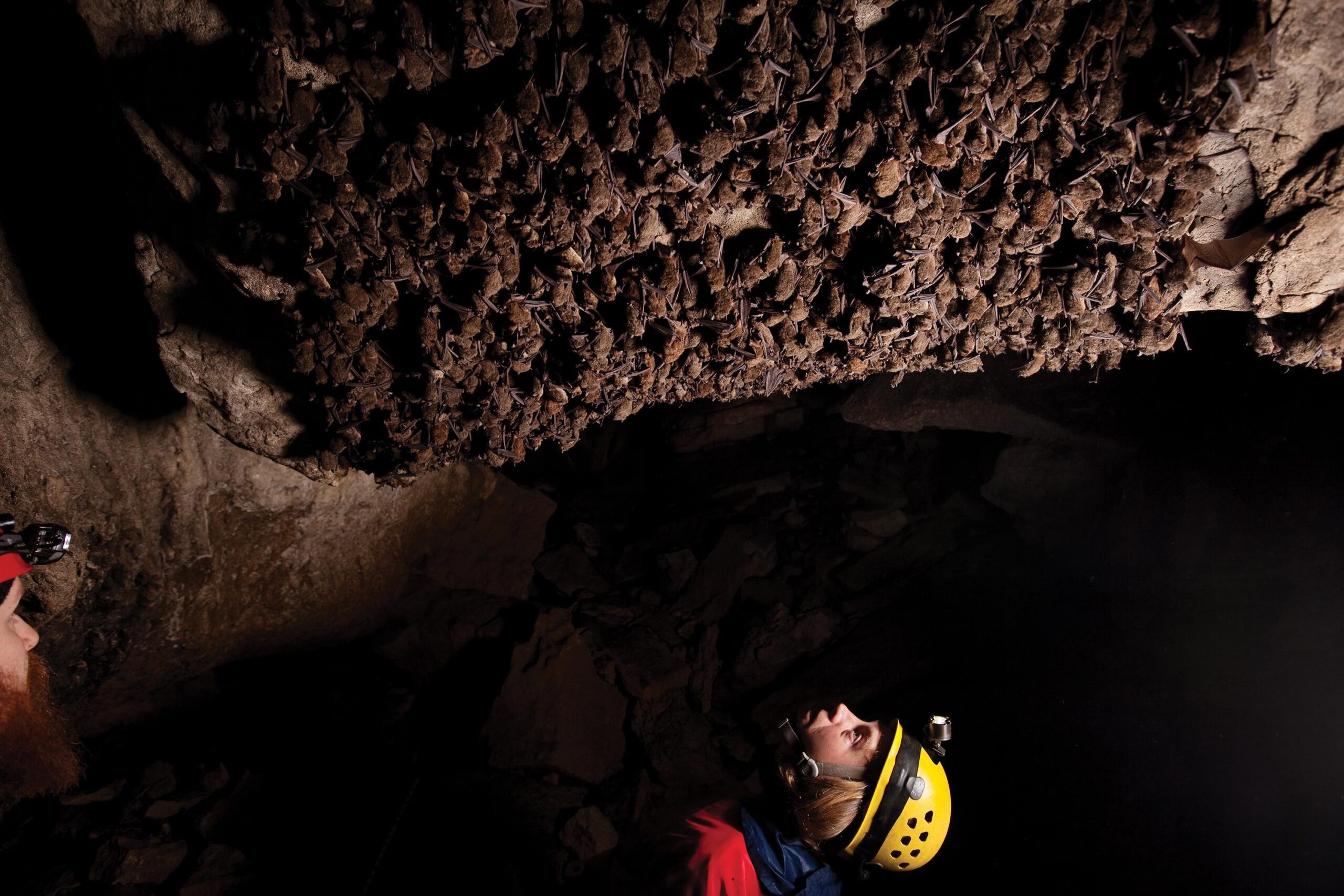Martin Davis turns onto a logging road and heads up, his Pathfinder jostling, toward the cave. It’s an overcast day in June, the kind when the mountaintops surrounding his home of Tahsis, B.C., are hidden among misty rain clouds. He has to ascend 650 metres above sea level, plus another 200 on foot. As the truck jerks, a little rubber bat — black wings extended, mouth open in a shout — falls off the dashboard.
British Columbia is home to Canada’s most diverse collection of bats, but surprisingly little is known about these 16 species, including exactly where many of them spend their time. Most hibernate for the winter, tucking away inside mines or caves with names like Deer Hell, featuring the skeletons of 11 animals who fell into the entrance; Labyrinth, a twisty maze; or today’s destination, Fracture Cave. Last December, Davis left equipment there to check for the presence of bats.
You may unsubscribe from any of our newsletters at any time.
As he nears the highest stretch of the road, he quickly steps on the brakes. A tree has fallen from the right side, entirely blocking any further motion. “Oh no!” he says. “I usually throw my chainsaw in the back.” Instead, he turns the vehicle around, hops out and prepares his bag for the hike ahead. He tosses the pack under the fallen log, crawls after it and sets on his way. A mangled sign, bent over and chewed on by black bears, announces this as Weymer Creek Provincial Park. He’s been coming here since he helped create the park in 1996 to protect a rare species of bat from commercial logging. Cavers maintain the trails, purposely keeping some of the way hidden to stop unprepared visitors from doing damage to sensitive caves and themselves.
Davis crosses the creek twice, trudges over mounds of late-spring snow and, more than an hour later, arrives at the entrance to the cave. When he first started exploring it over two decades ago, he thought the entrance, tucked at the base of an old-growth tree and ringed by unstable-looking boulders, would quickly collapse and disappear. But it’s still here, exactly the same.
The bats of Western Canada might not have that kind of longevity. A disease called white-nose syndrome, named for the white fungal spores that grow on the snouts and wings of infected individuals as they sleep through the winter, has decimated populations in the eastern parts of Canada and the United States. And it’s closing in.
A lot of people don’t like bats, but they’re often misunderstood. They’re not blind, though they are good at getting around in dark places, producing high-frequency shouts that reflect back and help them perceive their environment. They won’t suck your blood — the bats in Canada feed on insects. And for that reason, they’re incredibly important. The web of life is fragile. Remove one component, and the ripple-down effects can be drastic. A little brown bat, of which there were millions in Canada before the disease arrived, can eat between four and eight grams of insects each night. Collectively, a million little browns clear up to 1,300 metric tons of insects from the night sky each year. Many of those insects are pests that would otherwise destroy farmers’ crops — losing all of North America’s bats would cost the agriculture industry more than $3.7 billion each year. Others are mosquitoes that could pass diseases between humans.
Researchers in the United States estimate that the American population of little browns, among the first to be hit with the fungus, will be extirpated — extinct within the region — in less than 10 years. In Canada, white-nose syndrome has already infected multiple species in Ontario, Quebec, New Brunswick, Nova Scotia and Prince Edward Island, killing more than 90 percent of known little brown populations. As the disease spreads, observers in Western Canada are rushing to gather what data they can about their still-healthy bat populations. They’re facing mountainous odds, and sometimes great physical challenges, to give the bats a sliver of a chance at survival.
In March 2007, biologists in New York state were getting ready to survey the population of the mouse-eared Myotis sodalis bat in Hailes Cave, near Albany. The species has been listed as federally endangered since 1967, but the most recent survey had counted 685 of them hibernating among the more than 15,000 bats that used the cave. Almost immediately, it was clear that something was wrong.
The cave floor was covered in bones, bits of wings, entire bat bodies. Thousands of bats were missing, though raccoon and mink droppings surrounding the piles of body parts suggested that they ended up as a scavenged meal. Seven thousand living bats remained, none of them Myotis sodalis. About half had a fuzzy white substance on their faces, the only clue to what had happened. Three other caves in the state also had signs of the mysterious sickness, which scientists started calling white-nose syndrome after the strange look of the surviving bats. “None of the many bat researchers we contacted in the Eastern United States had ever seen it,” read a poster presented at a bat research conference in Mexico that August, “despite having collectively observed millions of hibernating bats.”

Cori Lausen, a recent PhD graduate from the University of Calgary, sat in the conference’s audience as American biologists shared their alarm and what little they knew. “Everybody was just dead silent and shocked,” she says. Lausen remembers feeling powerless, though she soon turned that into action. She had first studied the creatures for an undergraduate research project, and had left a job teaching high school to dedicate her life to learning more about them. A game-changing new threat gave her another reason to continue that work. She moved to British Columbia and dug in.
By the next year, it was clear that white-nose syndrome was not going away. After the winter of 2008, the situation at Hailes Cave had worsened: another 5,300 bats were dead, a 91 percent decline from the usual numbers. Other sites emptied out completely. Almost every cave checked within 130 kilometres of the original four was infected.
Here’s what we know now: a European bat, carrying the spores of a white fungus called Pseudogymnoascus destructans, likely hitched a ride on a container ship bound for New York. (Another common theory is that the fungus arrived in the United States on the clothes of a caver.) In Europe and Asia, hibernating bats developed resistance to the fungus after evolving alongside it for generations. But the North American bats that came in contact with patient zero had no built-in defence. The fungus invades their skin tissue, disrupting their water balance as they hibernate for the winter. The thirsty bats rouse, drawing on the fat stores they need to survive until spring. After this happens enough times, they need food — fast. Since there aren’t any insects for them to eat out in the cold winter landscape, the bats starve.
The fungus spread farther, reaching into central Canada by 2010. The federal government declared three of the hardest-hit species “endangered” in 2014. At least 5.7 million bats died between 2006 and 2012 in Canada and the United States. The disease was expected to spread across the continent, infecting the West Coast as early as 2025.
Lausen, who now works for Wildlife Conservation Society Canada, wanted to make the most of that time. First, she had to know where the bats were. In the East, bats congregated in groups of hundreds or thousands in giant hibernation sites. No such locations were documented in British Columbia or Alberta, and Lausen knew she didn’t have the skill set to scour deep, sometimes dangerous cave systems in search of them. Martin Davis, however, did.
When he was eight years old, Davis toured a cave in Virginia with his parents. “I was hooked immediately,” he says. At 13, he convinced the McMaster University caving club in Hamilton, where he grew up, to let him join in on their expeditions. He overcame a childhood fear of small spaces and was exploring caves as far as Mexico by 18. Caving brought him into contact with bats, and he did some work protecting and researching them in the 1990s. Now 60, he has the skills to get into hard-to-reach places, decades of experience and an extensive network in the caving community.
Lausen approached him with an idea that eventually turned into a program called BatCaver: if Davis and a team of volunteers across British Columbia and Alberta left data collectors inside caves over the winter, they could start to find and map the West’s bat populations.

The rain is still holding off as Davis reaches the mouth of the cave. The entrance slopes down and bends to the left before a two-and-a-half-metre drop, which he’ll travel through by rope. He turns on his helmet light, slips on his harness and gets ready to descend. If he’s not back within an hour, I’m to retrace our steps down the mountain, retrieve his hidden spare keys for the truck, drive back to the village, call for help. A minor injury could become fatal for cavers, who rely on their strength to bring themselves safely back to the surface. Get stuck, and it could be days before anyone finds you. Davis says that Canada hasn’t had a caving fatality since 1992, but it doesn’t hurt to be careful.
He backs into the cave, holding on to the rope. His view of the surface disappears as he makes the drop into the large underground passage. He often loses track of time in caves; calm and dark, they feel like a whole other world. About 50 metres away, he finds it: the acoustic data collector. He waves a small magnet in front, and it flashes red. This means it’s still working, recording nearby sounds, like the echolocation shouting of a bat flying by. He takes it and continues down the passage to grab the second collector, a small white cylinder at the end of a metal coil that’s tracking the temperature and humidity.
Getting back out is a little trickier. Metal pieces that can slide up but not down attach to the rope to support his feet and hands. He climbs inchworm-style up the rope until he reaches the initial slope. Pushing against it with his feet, he ascends the last few metres and emerges out of the hole.
Bat conservationists in Washington state also thought they had about 10 years to prepare for the arrival of the disease. On March 11, 2016, a little brown bat, near death, was found 48 kilometres from Seattle and sent to a local wildlife rehabilitation centre. Two days later, it was dead. It tested positive for white-nose syndrome.
At first, Lausen wondered if the news was a false alarm; there had been one before. As she listened in on a conference call about the new discovery, she couldn’t deny it: white-nose syndrome had jumped to the West Coast, and it was at her doorstep. “I was feeling pretty desperate,” she says. “We thought we had so much more time.” She called an emergency meeting of the BC Bat Action Team, a group dedicated to bat conservation. It had never met in person before.
Twenty-two biologists gathered at a hostel near Chase, B.C., last September and spent two days discussing potential actions. “It definitely galvanized us as a group,” says Leigh Anne Isaac, the team’s co-ordinator. “It helped us understand what needed to happen immediately.” They released a plan, stuffed with 83 actions grouped into categories and prioritized into three levels. Lausen says that a few things rose to the top.
Step one: find the bats. Along with BatCaver, the action team decided it was important to strengthen the recently launched North American Bat Monitoring Program, which uses sound detectors to track population numbers in the summer. The hope is to build a database record of different bat species over time.
The province’s community bat programs, another initiative prioritized at the emergency meeting, recruit local volunteers to add to that data set. Observers sit outside known colonies in the summer, counting each bat as it flies by. The original purpose of the regional programs was to give information to people who find bats living on their property, but they’ve also evolved into vital soldiers on the front line of white-nose syndrome, taking calls from the public about dead bats that are then tested for the disease.
Step two: figure out some way to help the bats survive. There’s promising research into compounds that could be sprayed on a bat to slow the progression of the disease. But the timeline for getting the remedy field tested and approved is long, to make sure it isn’t harmful for other parts of the ecosystem — and the bats in the East are already suffering.
“People are thinking it will eventually help the West, but I really don’t think it’s going to,” says Lausen. BatCaver hasn’t found the “motherlode of bats” that she was originally hoping to uncover. Save for a couple of sites with hundreds of bats in Alberta, most of the bats they’ve located hibernate in smaller, more spread-out clusters. It would have been easy to go into a cave filled with thousands of bats in Eastern Canada and spray them with a substance to help them survive; not so in the West, where you’d have to track them down one by one. There’s some hope that white-nose syndrome might not spread as quickly among bats that rest farther apart, but there’s no way to know until it arrives.
Lausen’s exploring other options. With a cave microbiologist, she’s identified some bacteria and fungi that naturally occur on bats’ wings and slow the growth of the white-nose fungus. These could be added in high concentrations to summer colony entrances, which bats would rub against on the way in and out, picking up the helpful microorganisms. The pair has applied for funding to test the idea.
In New York, 10 years after the disease first appeared, a few colonies have survived, persisting at five to 30 percent of their original size. They seem to have found some way to fight the fungus. If so, it’s possible a small number of bats could survive across the continent. But they breed slowly, one pup a year. It would take generations upon generations to get back to their original levels, in a time when they’re facing other threats from climate change, industry and wind power. Even the most hopeful admit that it’s going to be a rough time.
The day after Davis returns from the cave, he pops open the case of the acoustic data logger, puts its memory card into his laptop and looks at the graph. The frequencies plotted on his screen, brief bursts of sound repeating every second, look like bat calls. But as he flips through the rest of the winter’s data, he starts to second-guess himself. The data points aren’t linear enough, the shapes not cohesive. “I wonder if I’m wrong about this and if it’s a drip or something,” he says.
A couple of minutes later, he’s decided: they probably aren’t bat calls at all. The local bat populations don’t use Fracture Cave every year, and it looks like they went elsewhere this time.
Data sets like this, empty of bat voices, could become all too common in a year or two if the white-nose fungus hits the West. Until then, all Davis can do is soldier forward. Soon, he’ll embark on another hike, descend into another cave, retrieve another bat logger and share the data with Lausen and her team. Maybe this time they’ll find some bats. “I just have to have hope,” Lausen says, “that we’re going to be able to do something.”
This story originally appeared in the September 2017 issue of The Observer with the title “Bat Patrol.”














